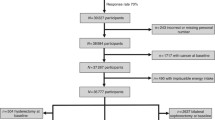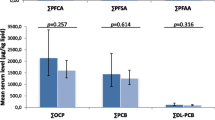Abstract
Objectives: Endogenous and exogenous estrogens are important in the development of endometrial cancer. Several organochlorine compounds, such as o,p′-DDT, have estrogenic properties. The objective of this case-control analysis was to examine serum concentrations of organochlorine compounds and risk of endometrial cancer.
Methods: Analyses were based on a sample of 90 endometrial cancer cases and 90 individually matched community controls from a multicenter case-control study in five geographic regions of the United States. Information on potential confounders, including menstrual and reproductive factors, cigarette smoking, diet, and weight, was obtained by interview.
Results: The adjusted relative risk of endometrial cancer in the highest quartile of exposure compared with women in the lowest quartile was 0.7 (95 percent confidence interval [CI] = 0.2-2.0) for p,p′-DDE, and 0.9 for total polychlorinated biphenyls (PCBs) (CI = 0.4-2.5).
Conclusions: These findings do not support the hypothesis that organochlorine compounds are linked to the development of endometrial cancer.
Similar content being viewed by others
References
IPSC International Program on Chemical Safety. DDT and its Derivatives-Environmental Aspects. Geneva, Switzerland: World Health Organization, 1987; Environmental Health, Criteria 83.
Wolff MS, Toniolo P, Lee E, Rivera M, Dubin N. Blood levels of organochlorine residues and risk of breast cancer. J Natl Cancer Inst 1993; 85: 648–52.
Dewailly E, Dodin S, Verreault R, Ayotte P, Sauve L, Morin J. High organochlorine body burden in women with estrogen receptor positive breast cancer. J Natl Cancer Inst 1994; 86: 232–4.
Falck FY, Ricci A Jr, Wolff MS, Godbold J, Deckers J. Pesticides and polychlorinated biphenyl residues in human breast lipids and their relation to breast cancer. Arch Environ Health 1992; 47: 143–6.
Krieger N, Wolff MS, Hiatt RA, Rivera M, Vogelman J, Orentreich N. Breast cancer and serum organochlorines: a prospective study among white, black and Asian women. J Natl Cancer Inst 1994; 86: 589–99.
Lopez-Carrillo L, Blair A, Lopez-Cerbantes M, et al. Dichlorodiphenyl-trichlorethane serum levels and breast cancer risk: a case-control study from Mexico. Cancer Res 1997; 57: 3728–32.
Hunter DJ, Hankinson SE, Laden F, et al. Plasma organochlorine levels and the risk of breast cancer. N Engl J Med 1997; 337: 1253–8.
van’ t Veer P, Lobbezoo IE, Martin-Moreno JM, et al. DDT (dicophane) and postmenopausal breast cancer in Europe: case-control study. Br Med J 1997; 315: 81–5.
Mussalo-Rauhamaa H, Hasanen E, Pyysalo H, Antervo K, Kauppila R, Pantzar P. Occurrence of beta-hexachlorocyclohexane in breast cancer patients. Cancer 1990; 66: 2124–8.
Moysich KB, Ambrosone CB, Vena JE, et al. Environmental organochlorine exposure and postmenopausal breast cancer risk. Cancer Epidemiol Biomark Prev 1998; 7: 181–8.
Galand P, Mairesse N, Degraef C, Rooryck J. o,p′-DDT (1,1,1,-trichloro-2 (p-chlorophenyl) 2-(o-chlorophenyl)-ethane is a purely estrogenic agonist in the rat uterus in vivo and in vitro. Biochem Pharmacol 1987; 36: 397–400.
Shekhar PVM, Werdell J, Basrur VS. Environmental estrogen stimulation of growth and estrogen receptor function in preneoplastic and cancerous human breast cell lines. J Natl Cancer Inst 1997; 89: 1774–82.
Bulger WH, Kupfer D. Estrogenic action of DDT analogs. Am J Ind Med 1983; 4: 163–73.
Kelce WR, Stone CR, Laws SC, Gray LE, Kemppainen JA, Wilson EM. Persistent DDT metabolite p,p′-DDE is a potent androgen receptor antagonist. Nature 1995; 375: 581–5.
Kimbrough RD. Polychlorinated biphenyls (PCBs) and human health: An update. Crit Rev Toxicol 1995; 25: 133–63.
Korach KS, Sarver P, Chae K. Estrogen receptor-binding activity of polychlorinated biphenyls: conformationally restricted structural probes. Mol Pharmacol 1988; 33: 120–6.
Wolff MS, Camann D, Gammon M, et al. Proposed PCB congener groupings for epidemiologic studies. Environ Health Perspect 1997; 105: 13–14.
Safe S. Toxicology, structure-function relationship and human and environmental health impacts of polychlorinated biphenyls: progress and problems. Environ Health Perspect 1992; 100: 259–69.
Brinton LA, Schairer C. Estrogen replacement therapy and breast cancer risk. Epidemiol Rev 1993; 15: 66–79.
Adami HO, Lipworth L, Titus-Ernstoff L, et al. Organochlorine compounds and estrogen-related cancers in women. Cancer Causes Control 1995; 6: 551–66.
Brinton LA, Berman ML, Mortel R, et al. Reproductive, menstrual, and medical risk factors for endometrial cancer: Results from a case-control study. Am J Obstet Gynec 1992; 167: 1317–25.
Schwartz SM, Thomas DB. The World Health Organization Collaborative Study of Neoplasia and Steroid Contraceptives. A case-control study of risk factors for sarcomas of the uterus. Cancer 1989; 64: 2487–92.
Brock JW, Burse VW, Ashley DL, et al. An improved analysis for chlorinated pesticides and polychlorinated biphenyls (PCBs) in human and bovine sera utilizing solid phase extraction. J Anal Toxicol 1996; 20: 528–36.
Phillips DL, Pirkle JL, Burse VW, et al. Chlorinated hydrocarbon levels in human serum: effects of feeding and fasting. Arch Environ Contam Toxicol 1989: 18: 495–500.
Elwood JM, Cole P, Rothman KJ, Kaplan SD. Epidemiology of endometrial cancer. J Natl Cancer Inst 1977; 59: 1055–60.
Swanson CA, Potischman N, Wilbanks GD, et al. Risk of endometrial cancer in relation to contemporary and past body size. Cancer Epidemiol Biomark Prev 1993; 2: 321–70.
Potischman N, Swanson CA, Brinton LA, et al. Dietary associations in a case-control study of endometrial cancer. Cancer Causes Control 1993; 4: 239–50.
Baron JA, Byers T, Greenberg ER. Cigarette smoking in women with cancers of the breast and reproductive organs. J Natl Cancer Inst 1986; 77: 677–80.
Brinton LA, Barrett RJ, Berman ML, et al. Cigarette smoking and the risk of endometrial cancer. Am J Epidemiol 1993; 137: 281–91.
Potischman N, Hoover RN, Brinton LA, et al. Casecontrol study of endogenous steroid hormones and endometrial cancer. J Natl Cancer Inst 1996; 88: 1127–35.
Author information
Authors and Affiliations
Rights and permissions
About this article
Cite this article
Sturgeon, S.R., Potischman, N., Rothman, N. et al. Serum concentrations of organochlorine compounds and endometrial cancer risk (United States). Cancer Causes Control 9, 417–424 (1998). https://doi.org/10.1023/A:1008823802393
Issue Date:
DOI: https://doi.org/10.1023/A:1008823802393




